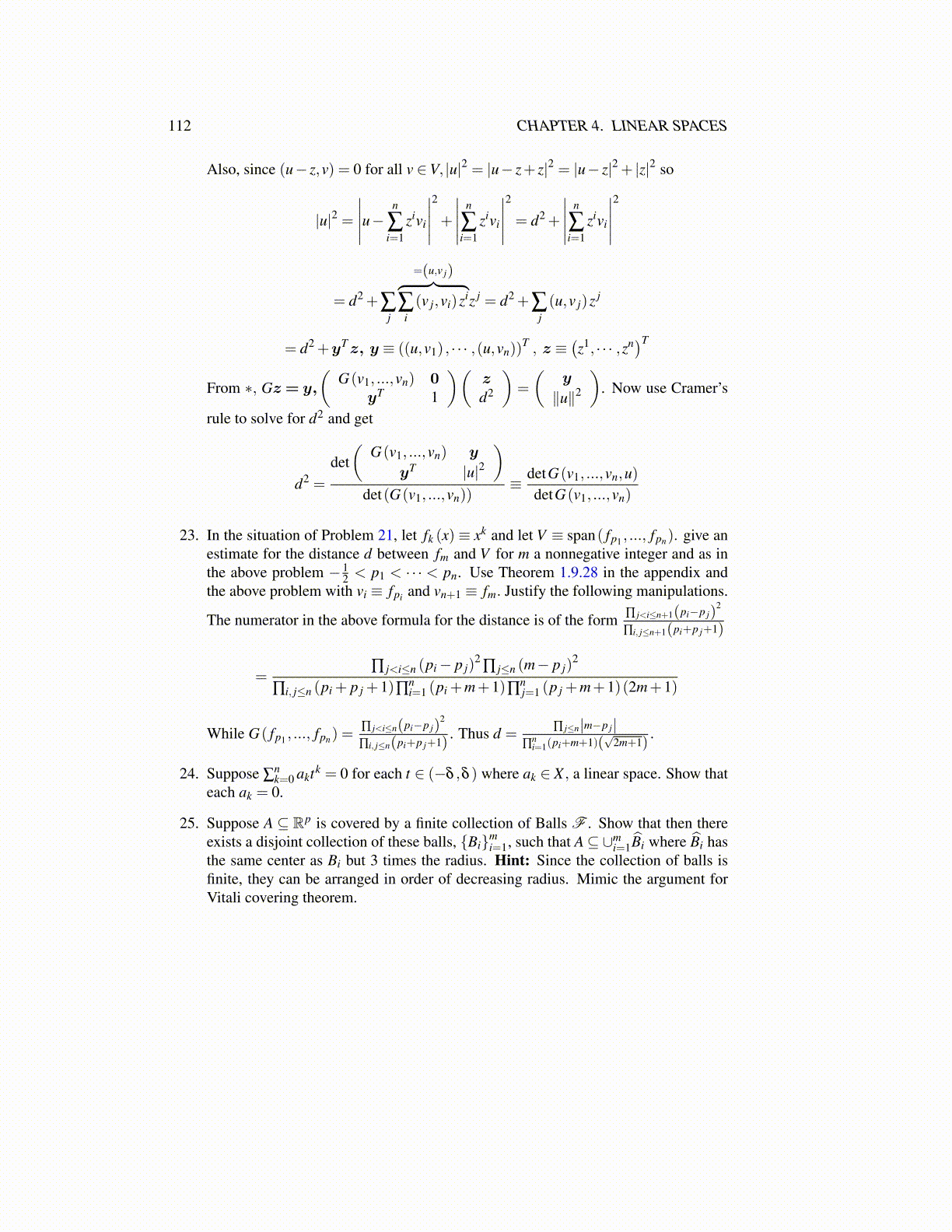
112 CHAPTER 4. LINEAR SPACES
Also, since (u− z,v) = 0 for all v ∈V, |u|2 = |u− z+ z|2 = |u− z|2 + |z|2 so
|u|2 =
∣∣∣∣∣u− n
∑i=1
zivi
∣∣∣∣∣2
+
∣∣∣∣∣ n
∑i=1
zivi
∣∣∣∣∣2
= d2 +
∣∣∣∣∣ n
∑i=1
zivi
∣∣∣∣∣2
= d2 +∑j
=(u,v j)︷ ︸︸ ︷∑
i(v j,vi)ziz j = d2 +∑
j(u,v j)z j
= d2 +yTz, y ≡ ((u,v1) , · · · ,(u,vn))T , z ≡
(z1, · · · ,zn)T
From ∗, Gz = y,
(G(v1, ...,vn) 0
yT 1
)(zd2
)=
(y
∥u∥2
). Now use Cramer’s
rule to solve for d2 and get
d2 =
det(
G(v1, ...,vn) y
yT |u|2)
det(G(v1, ...,vn))≡ detG(v1, ...,vn,u)
detG(v1, ...,vn)
23. In the situation of Problem 21, let fk (x)≡ xk and let V ≡ span( fp1 , ..., fpn). give anestimate for the distance d between fm and V for m a nonnegative integer and as inthe above problem − 1
2 < p1 < · · · < pn. Use Theorem 1.9.28 in the appendix andthe above problem with vi ≡ fpi and vn+1 ≡ fm. Justify the following manipulations.
The numerator in the above formula for the distance is of the form ∏ j<i≤n+1(pi−p j)2
∏i, j≤n+1(pi+p j+1)
=∏ j<i≤n (pi− p j)
2∏ j≤n (m− p j)
2
∏i, j≤n (pi + p j +1)∏ni=1 (pi +m+1)∏
nj=1 (p j +m+1)(2m+1)
While G( fp1 , ..., fpn) =∏ j<i≤n(pi−p j)
2
∏i, j≤n(pi+p j+1). Thus d =
∏ j≤n|m−p j|∏
ni=1(pi+m+1)(
√2m+1)
.
24. Suppose ∑nk=0 aktk = 0 for each t ∈ (−δ ,δ ) where ak ∈ X , a linear space. Show that
each ak = 0.
25. Suppose A ⊆ Rp is covered by a finite collection of Balls F . Show that then thereexists a disjoint collection of these balls, {Bi}m
i=1, such that A⊆∪mi=1B̂i where B̂i has
the same center as Bi but 3 times the radius. Hint: Since the collection of balls isfinite, they can be arranged in order of decreasing radius. Mimic the argument forVitali covering theorem.